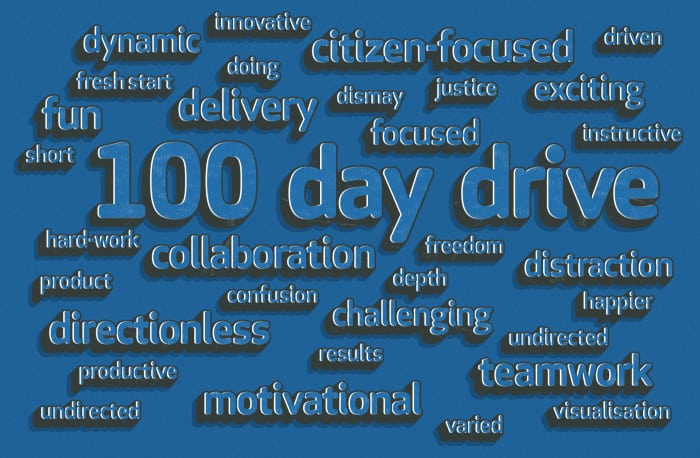Digital
Team’s feedback on the first 100-day drive
July 6, 2015 by Jono Ellis No Comments | Category Digital Public Services, mygov.scot
This is a post by Jono Ellis, our Social Media Manager
We posted an update during our first 100-day drive to let people about how things were progressing. As we progress into the second 100-day drive, it seems like a good time to reflect on how people felt about both the approach and what we delivered over the period.
The drive was set up with four main areas;
- deliver with the Justice cluster, using user-centric research methods and beginning to build upon our relationship
- establish a more radical and dynamic approach to content, surfacing priority services from across the public sector
- establish partnerships and assessing opportunities for reuse
- moving to using a lean kanban method for managing flow
This focus on four key workstreams was to provide the teams with a clear set of objectives. In order to understand just how well things worked we gathered feedback from the team by asking what they thought.

We’ve collated some of most interesting comments.
Feedback on the approach
As well as reflecting on the work that we were doing people also shared their thoughts on the focus on short-term objectives through regular drives. Although mainly positive, not everything was perceived as working perfectly.
Positives included that the drive provided a “focused effort for the team” and…
“The regained focus in the quality of the product was, for me, the highlight of the 100 days”
“A few setbacks, but it showed good indications of our capacity to deliver”
“The 100 days was a great way to establish a high-level checkpoint”
Negatives included…
“I believe there is ‘cultural debt’ that needs to be addressed. Ways of working and shared values could perhaps be a focus next”
“I was disappointing that there was not a satisfactory conclusion, where we could celebrate our achievements”
Feedback on our delivery
The Justice Digital Strategy aims to increase access to information about the justice process in Scotland. Our involvement was to work collaboratively with Justice colleagues to create user centric content through www.mygov.scot.
“Work that we are doing could help vulnerable people avoid being in financial difficulty by providing the right information to them at that life event”
“Collaboration with the specific Justice policy team was essential and their guidance was critical, with a keen eye for detail and semantics”
“Engaging with Third Sector organisations provided a true account of the citizens needs from an evolving government”
“Working in a collaborative team… building user journey for a citizen facing repossession… we defined the brief, undertook research, created content and ways of interacting… followed up with usability testing… for me it was the full circle of user centred design.”
We also made technological advances and transitioned legacy websites.
“Great to see open sourcing has started”
“Adopting Amazon Web Services was a big step forward”
“…highlights were the decommissioning of alpha and Directscot”
We switched from Scrum to Kanban for managing our workflow and we used the period to help bed this in.
“… seeing the collaboration levels… constantly rising… working more as one team rather than being in silos”
“Better collaboration after introducing Kanban”
“Seeing how well our… teams can work together when… empowered to make our own decisions”
User research and user testing bookended much of our work.
“Joining a great team, delivering some excellent content and doing insightful user research”
“Seeing the content on a user acceptance testing environment made the demo to stakeholders a really positive experience”
“Positive feedback from highlighting the before and after impact content / UX / design can make to citizens”
There were also efforts to make better use of data, helping to improve the structure and prioritisation of content.
“The information architecture work that has started has been really positive and has already generated some great ideas”
“Having the expertise to put SEO and analytics into a space where we start to work proactively to define, design and measure is a huge step forward”
Finally, hackathons provide a counterpoint to the intense focus on delivery, giving team members an opportunity to tackle other interesting projects. People said the hackathons “have both been fun and delivered value” and “The last 2 hackathons have been excellent”
Summary
Overall the team were mostly happy with the format, so we’re now already into the second 100-day drive and are making changes to improve things based upon this feedback. We have a great foundation to build upon now, so I’m excited to see the results.
If you missed the blog post about the launch of the second 100-day drive, I’d recommend reading this.
We’ll be sharing updates on these features, and much more on social, so follow the team via @mygovscot on Twitter for more updates. Want to comment? Let us know below!
Tags: Product

Leave a comment